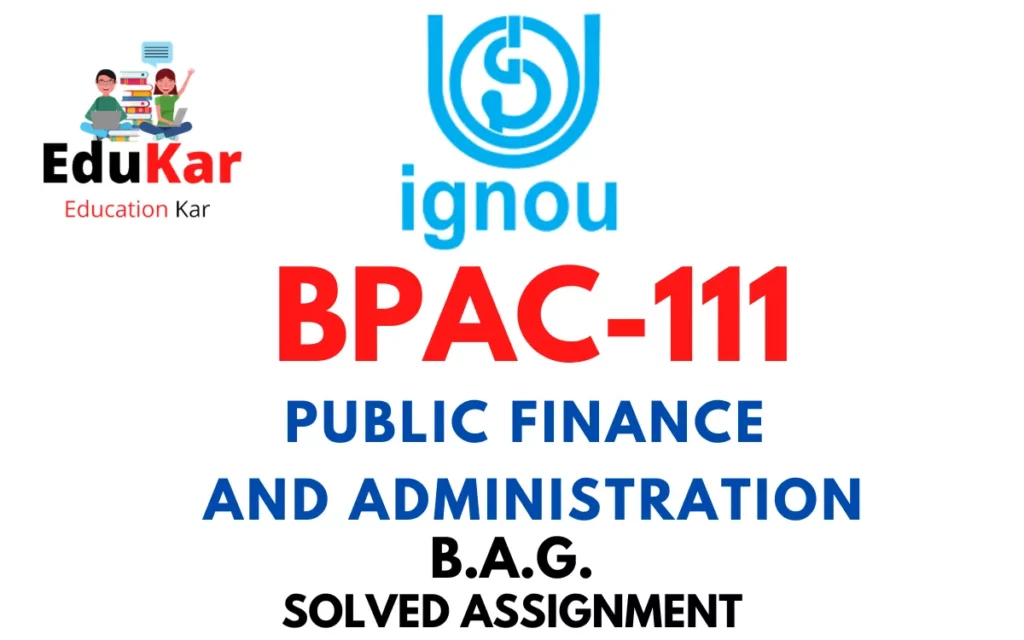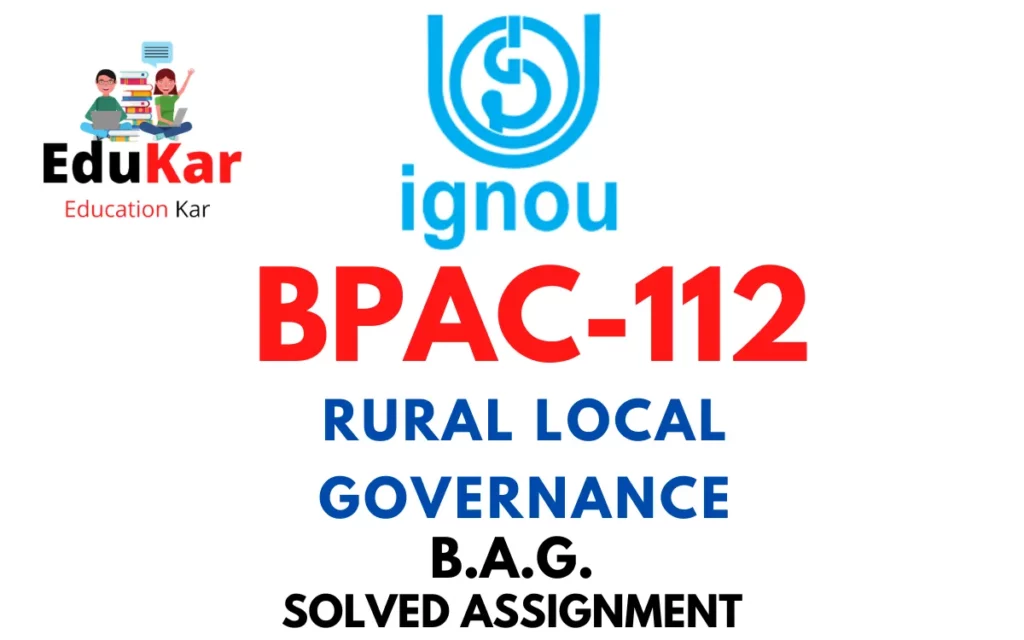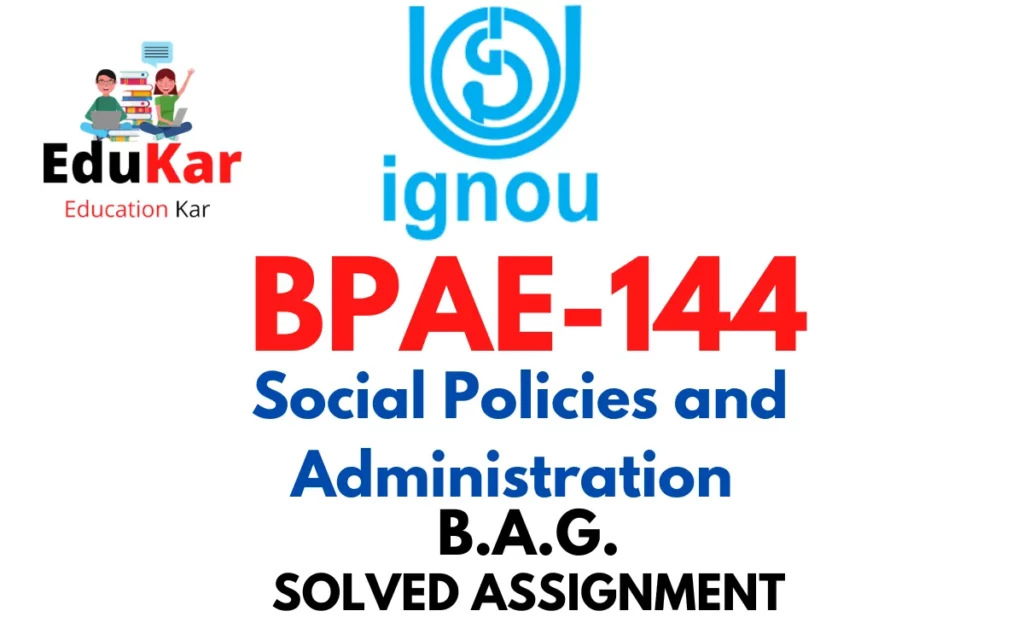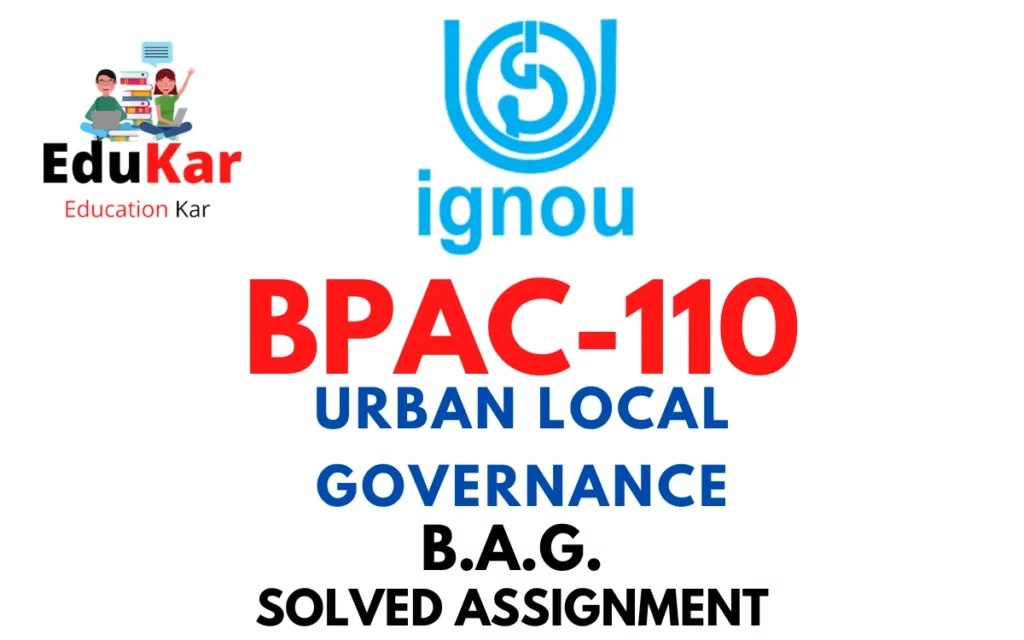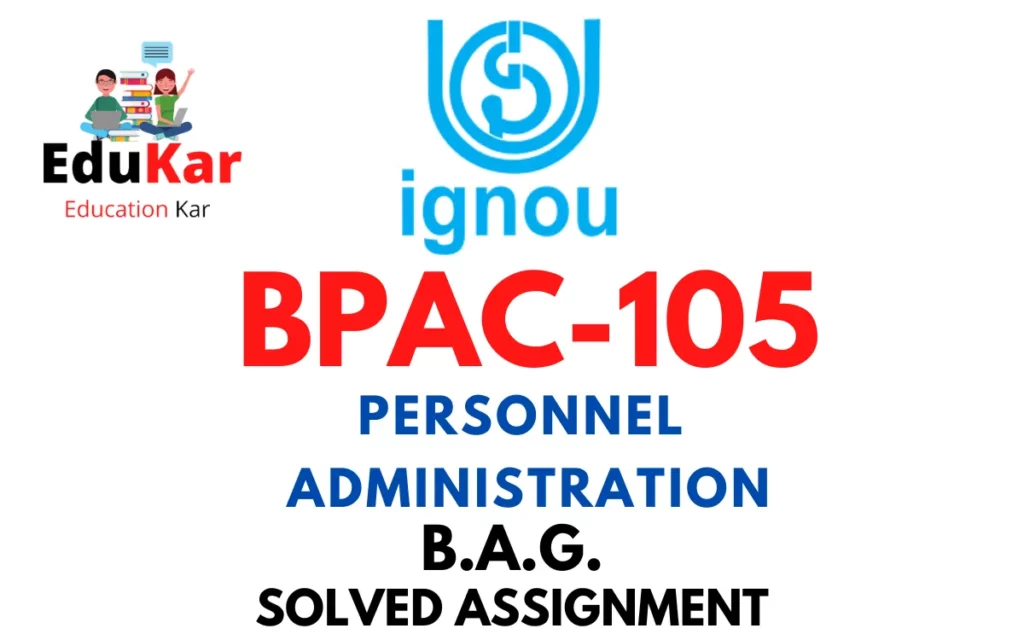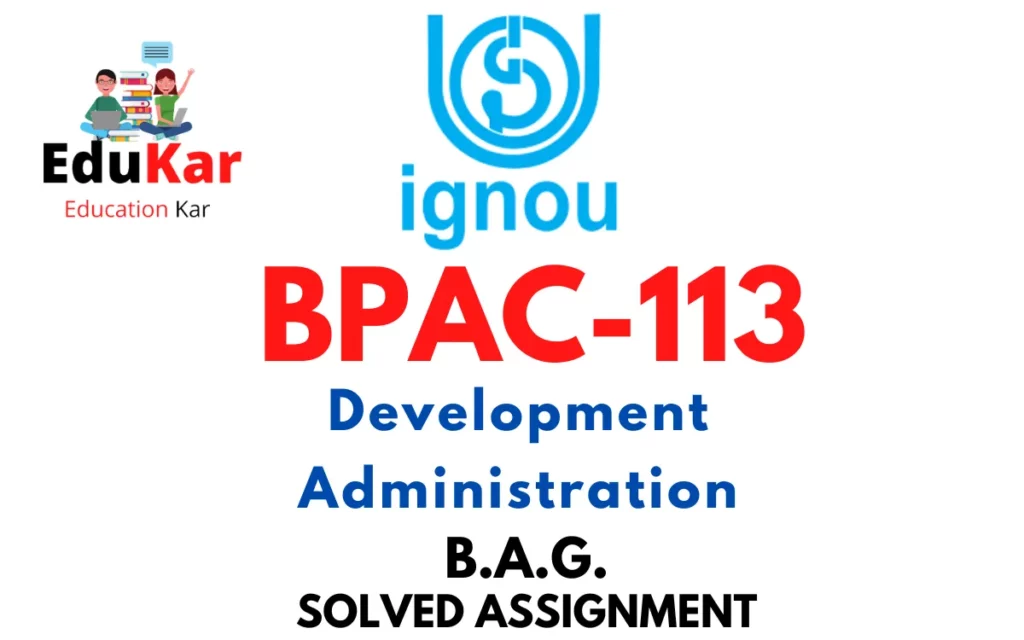Contents
- 1 Assignment A
- 2 Answer the following questions in about 500 words each.
- 3 1. Examine the role of State Planning Board.
- 4 2. Describe the organisational structure, powers and functions of the Lokayukta.
- 5 Assignment B
- 6 Answer the following questions in about 250 words each.
- 7 3. Highlight the position and functions of the Chief Secretary.
- 8 4. What are the various ways through which the Legislature exercises its control over administration?
- 9 5. Discuss the powers and functions of Panchayati Raj Institutions.
- 10 Assignment C
- 11 Answer the following questions in about 100 words each.
- 12 6. Write a note on the trends of urbanisation in India.
- 13 7. What do you mean by the status-quo approach?
- 14 8. Highlight the power of State Election Commission as a Civil Court.
- 15 9. Describe the significance of State Finance Commission.
- 16 10. Discuss the powers and functions of the Gram Panchayat.
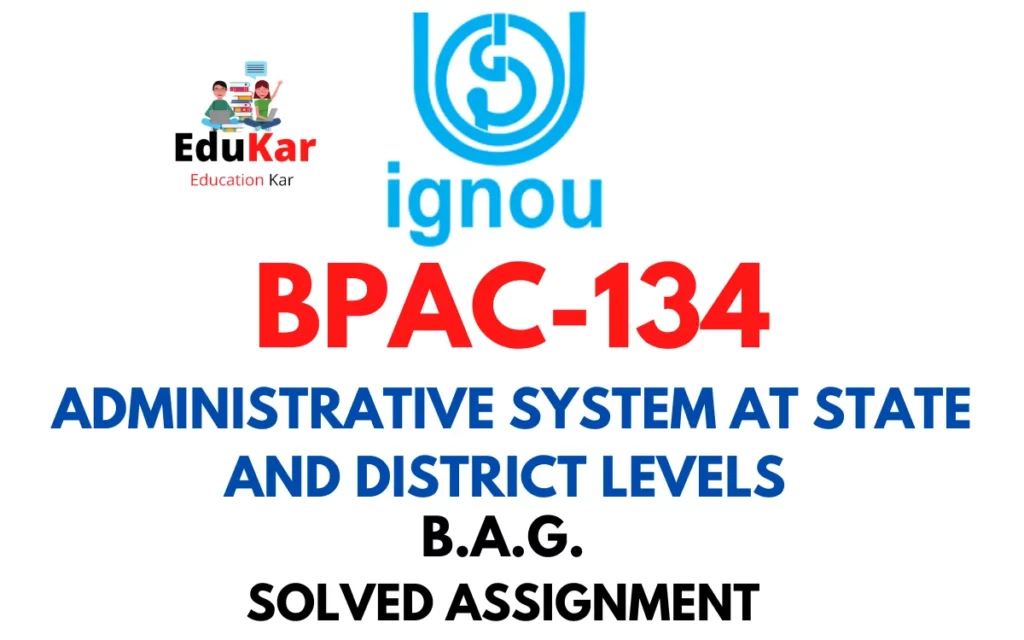
| Title | BSOC-132: IGNOU BAG Solved Assignment 2022-2023 |
| University | IGNOU |
| Degree | Bachelor Degree Programme |
| Course Code | BPAC-134 |
| Course Name | Administrative System At State And District Levels |
| Programme Name | Bachelor of Arts (General) |
| Programme Code | BAG |
| Total Marks | 100 |
| Year | 2022-2023 |
| Language | English |
| Assignment Code | ASST/TMA/JULY 2022 & JANUARY 2023 |
| Last Date for Submission of Assignment: | For June Examination: 31st April For December Examination: 30th September |
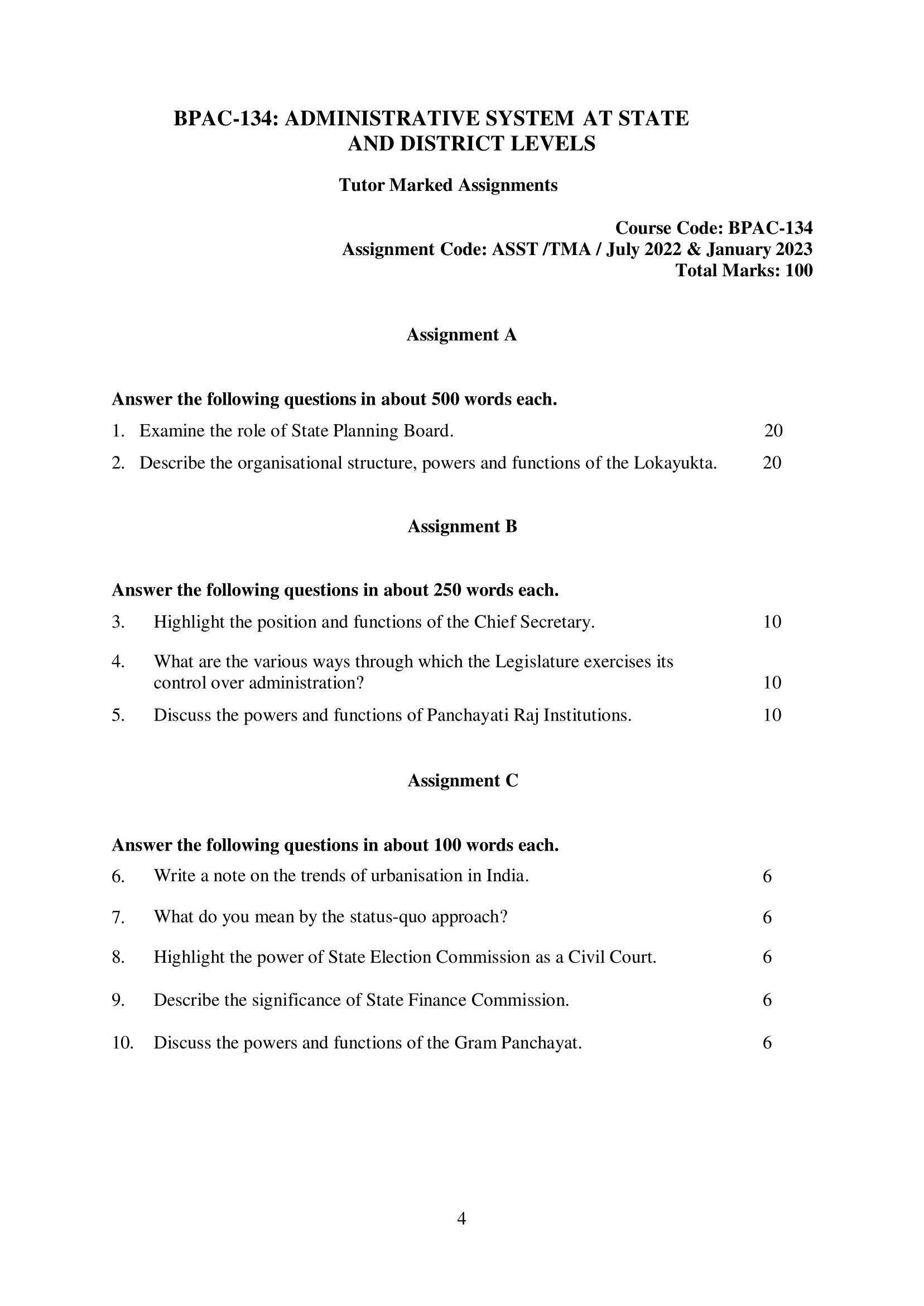
Assignment A
Answer the following questions in about 500 words each.
1. Examine the role of State Planning Board.
Ans: The State Planning Board (SPB) is a specialized body that advises the state government on matters related to planning and development. It is responsible for formulating plans, policies, and programs for the balanced and sustainable development of the state. The board plays a crucial role in channelizing the state’s resources towards socio-economic growth and achieving its development objectives.
The primary role of the SPB is to prepare a comprehensive development plan for the state. The plan takes into account the state’s natural resources, the economic and social needs of its people, and the existing infrastructure. The plan identifies the goals, targets, and strategies for the state’s development and helps to align public policies and programs with these objectives. The SPB also monitors the progress of plan implementation and recommends mid-course corrections where necessary.
The SPB also plays a critical role in ensuring that public resources are allocated efficiently and effectively. It advises the government on budget allocation, public expenditure, and revenue mobilization. It also suggests measures to improve tax collection and to enhance the efficiency of public spending. The board helps to prioritize investment in key sectors such as health, education, agriculture, infrastructure, and industry, which are crucial for the state’s development.
In addition to planning and budgeting, the SPB also provides a forum for dialogue and consultation among different stakeholders. It engages with civil society organizations, private sector actors, and academia to gather inputs and feedback on policy and program design. It also disseminates information on the state’s development initiatives and seeks public participation in the planning process. The board’s consultative approach helps to build consensus and ownership for development policies, making them more effective and sustainable.
The SPB also helps to promote innovation and knowledge-sharing. It facilitates research and analysis on development issues and disseminates best practices and lessons learned. It also provides technical assistance to state departments and local governments in project design, implementation, and monitoring. The board’s technical support helps to build capacity at the grassroots level and ensures that development interventions are evidence-based and grounded in local needs and realities.
2. Describe the organisational structure, powers and functions of the Lokayukta.
Ans: The Lokayukta is an anti-corruption ombudsman institution in India that aims to address cases of corruption and maladministration in the public sector. The Lokayukta has a vital role in ensuring accountability and transparency in governance, and its powers and functions are enshrined in the relevant state legislation. In this answer, we will discuss the organizational structure, powers, and functions of the Lokayukta in India.
Organizational Structure: The Lokayukta is headed by a single member or a chairperson, who is a retired judge of the Supreme Court or a High Court, or a person with similar qualifications. The Lokayukta may also have up to three members, appointed by the Governor on the recommendation of the Chief Minister and with the consultation of the Chief Justice of the High Court. The members must have experience in law, public administration, or social work.
Powers: The Lokayukta has powers to investigate complaints of corruption and maladministration against public servants, including the Chief Minister, Members of the Legislative Assembly (MLAs), Members of Parliament (MPs), and bureaucrats. The Lokayukta has the power to conduct inquiries, summon witnesses, and call for documents to assist in investigations. It can also recommend punishment or initiate criminal proceedings against public officials involved in corrupt practices.
Functions: The primary function of the Lokayukta is to receive complaints of corruption and maladministration from citizens, investigate them, and take necessary action. The Lokayukta can investigate matters related to corruption, abuse of power, favoritism, and nepotism, among others. It can also make recommendations to the government on ways to improve transparency and accountability in governance. Additionally, the Lokayukta can conduct spot inspections, review the functioning of public institutions, and issue reports and recommendations.
The Lokayukta can also assist in resolving grievances and disputes related to public services. It can act as a mediator between citizens and government departments, facilitate the resolution of complaints, and make recommendations to improve service delivery.
Assignment B
Answer the following questions in about 250 words each.
3. Highlight the position and functions of the Chief Secretary.
Ans: The Chief Secretary is the most senior civil servant in a state or province of India, and plays a critical role in the administration of the state. The position of Chief Secretary is a top-level bureaucratic position, and is responsible for the overall management of the government’s administrative affairs.
The Chief Secretary’s primary role is to act as the principal advisor to the Chief Minister and other senior political leaders on all matters related to governance and administration. This involves providing strategic advice on policy matters, coordinating the implementation of government programs and initiatives, and ensuring that government policies are executed effectively.
In addition to advising the government, the Chief Secretary is also responsible for the day-to-day management of the state’s civil service. This includes overseeing the recruitment, training, and deployment of civil servants, as well as ensuring that they adhere to the highest standards of integrity and professionalism.
One of the most important functions of the Chief Secretary is to ensure that government decisions are implemented in a timely and efficient manner. This requires close coordination with other government departments and agencies, as well as with the private sector and civil society organizations.
The Chief Secretary also plays a key role in maintaining law and order in the state. This involves working closely with the police and other law enforcement agencies to ensure that citizens are protected from crime and violence.
4. What are the various ways through which the Legislature exercises its control over administration?
Ans: The Legislature, which represents the people, exercises control over administration in various ways in a parliamentary democracy like India. The following are some of the ways through which the Legislature exercises its control over the administration:
- Question Hour: The Question Hour is the first hour of every sitting of the Parliament when Members of Parliament can ask questions to Ministers regarding the policies and performance of their respective ministries.
- Adjournment Motion: The adjournment motion is a parliamentary procedure that enables MPs to debate a specific issue and seek a vote of no-confidence against the government.
- Debates: The Legislature can debate policies and issues and highlight the performance of the administration in various sectors, such as education, health, infrastructure, defense, foreign relations, etc.
- Committees: The Legislature appoints various committees to scrutinize and examine the functioning of different ministries and departments. These committees include the Public Accounts Committee, the Estimates Committee, the Committee on Subordinate Legislation, and others.
- Budgetary Control: The Legislature has the power to approve or reject the budget presented by the government. It can cut or increase allocations to various sectors and hold the administration accountable for the effective use of public funds.
- Motions of No Confidence: The Legislature can pass a vote of no confidence against the government, leading to the resignation of the government and the dissolution of the Parliament.
- Impeachment: The Legislature can impeach the President, Vice-President, Judges of the Supreme Court, and High Courts for misconduct, irregularities, or violating the Constitution.
5. Discuss the powers and functions of Panchayati Raj Institutions.
Ans: Panchayati Raj Institutions (PRIs) are a decentralized system of local governance in India. They were established through the 73rd Amendment to the Constitution of India in 1992. The main objective of PRIs is to provide democratic participation and decision-making power to people at the grassroots level. PRIs have three levels – Gram Panchayat at the village level, Panchayat Samiti at the block level, and Zila Parishad at the district level.
The powers and functions of PRIs are as follows:
- Preparation of plans – PRIs have the power to prepare plans for economic development and social justice at the local level.
- Implementation of plans – PRIs are responsible for implementing the plans prepared by them. They have the power to spend funds allocated to them by the government for the implementation of various schemes and programs.
- Decentralized planning – PRIs are responsible for preparing decentralized plans that are tailor-made for the specific needs and requirements of the local population.
- Rural development – PRIs are responsible for the development of rural areas. They have the power to undertake activities related to agriculture, animal husbandry, rural industries, and other such activities.
- Provision of basic services – PRIs are responsible for providing basic services such as healthcare, education, water supply, sanitation, and road connectivity in rural areas.
- Social justice – PRIs are responsible for ensuring social justice at the local level. They have the power to implement policies related to land reforms, poverty alleviation, and employment generation.
- Women and Child Development – PRIs have the responsibility of implementing various schemes related to women and child development in their respective areas.
- Empowerment of weaker sections – PRIs have the power to implement policies that are specifically aimed at empowering the weaker sections of society, such as Scheduled Castes, Scheduled Tribes, and other marginalized groups.
Assignment C
Answer the following questions in about 100 words each.
6. Write a note on the trends of urbanisation in India.
Ans: Urbanization in India has been a continuous process since the mid-20th century, with the country’s urban population growing rapidly over the past few decades. According to the 2011 Census of India, around 31% of the country’s population lives in urban areas, and this is projected to increase to over 40% by 2030. The trend of urbanization in India is driven by a combination of factors such as population growth, rural-urban migration, and the expansion of economic opportunities in urban areas. However, this trend also poses challenges such as overcrowding, inadequate infrastructure, and environmental degradation.
7. What do you mean by the status-quo approach?
Ans: The status-quo approach refers to a way of thinking or decision-making that maintains the current situation or the way things are done. It is a conservative approach that assumes that the current state of affairs is the best or the most appropriate, and that any change or deviation from it may have negative consequences.
In business or organizational contexts, the status-quo approach may manifest as a reluctance to adopt new technologies, processes, or practices, and a preference for sticking to established routines and procedures. This approach can lead to a lack of innovation and adaptability, and may cause an organization to fall behind its competitors.
In social or political contexts, the status-quo approach may result in resistance to social, economic, or political reforms, and a preference for maintaining the existing power structures and social norms. This approach can hinder progress towards greater equality and justice, and may perpetuate social injustices and inequalities.
8. Highlight the power of State Election Commission as a Civil Court.
Ans: The State Election Commission (SEC) in India is a constitutional body that oversees and conducts elections for local bodies such as municipalities, panchayats, and corporations. In addition to its role in conducting free and fair elections, the SEC also has certain powers and functions that are similar to those of a civil court.
Some of the key powers of the SEC that are similar to those of a civil court are:
- Summoning witnesses: The SEC can summon witnesses to give evidence in any matter related to the conduct of elections. This power is similar to that of a civil court.
- Taking evidence on oath: The SEC has the power to take evidence on oath, which is similar to the power of a civil court to administer oaths to witnesses.
- Imposing penalties: The SEC has the power to impose penalties on candidates, political parties, or any person found guilty of violating election rules. The SEC can also take action against officials who fail to discharge their duties, which is similar to the power of a civil court to impose fines and penalties.
- Enforcing orders: The SEC has the power to enforce its orders and decisions, and to take necessary measures to ensure compliance. This power is similar to the power of a civil court to enforce its orders and judgments.
- Dealing with election disputes: The SEC has the power to deal with election disputes and to decide on matters such as the validity of elections, the eligibility of candidates, and the counting of votes. This power is similar to that of a civil court in deciding on disputes between parties.
9. Describe the significance of State Finance Commission.
Ans: State Finance Commissions (SFCs) are constitutional bodies that are constituted every five years in India. They play a crucial role in the functioning of the country’s federal system. The primary objective of the SFC is to ensure financial autonomy to local governments in the States. The significance of the SFC can be described as follows:
- Decentralization of Funds: SFCs help in decentralizing the funds to the local governments, providing them with greater financial autonomy to carry out their functions and duties effectively.
- Sharing of Resources: SFCs help in determining the sharing of resources between the State and local governments. They also recommend the distribution of financial resources among various local bodies, such as municipalities, panchayats, and other autonomous bodies.
- Equitable Distribution of Funds: The SFCs promote the equitable distribution of resources among the local governments, particularly to those that are under-resourced and are in need of financial assistance.
- Strengthening Local Governments: SFCs help in strengthening the local governments by providing them with financial resources, which enables them to provide better public services to the citizens.
- Accountability: SFCs ensure that local governments are held accountable for their financial management, and they follow the norms and regulations set by the SFC.
- Inclusivity: SFCs ensure that the local governments are inclusive in nature and cater to the needs of all the sections of society, particularly the marginalized and underprivileged.
10. Discuss the powers and functions of the Gram Panchayat.
Ans: Gram Panchayat is the local self-government institution at the village level in India. It is the foundation of the Panchayati Raj system, established to promote decentralization and democracy at the grassroots level. The powers and functions of the Gram Panchayat include:
- Preparation of village development plans, implementation of the same and the allocation of funds for various development schemes.
- Provision of basic services such as water supply, sanitation, street lighting, maintenance of village roads, and providing assistance during natural disasters.
- Promoting and implementing social justice schemes related to health, education, employment, and welfare of vulnerable sections of society such as women, children, and senior citizens.
- Collecting taxes and fees such as house taxes, trade taxes, and entertainment taxes.
- Resolving disputes related to village-level issues such as land, property, and village boundaries.
- Promotion of rural industries, agricultural and allied activities.
- Registering births, deaths, and marriages and maintaining vital records in the village.
How to Download BPAC-134 Solved Assignment?
You can download it from the www.edukar.in, they have a big database for all the IGNOU solved assignments.
Is the BPAC-134 Solved Assignment Free?
Yes this is absolutely free to download the solved assignment from www.edukar.in
What is the last submission date for BPAC-134 Solved Assignment?
For June Examination: 31st April, For December Examination: 30th October


